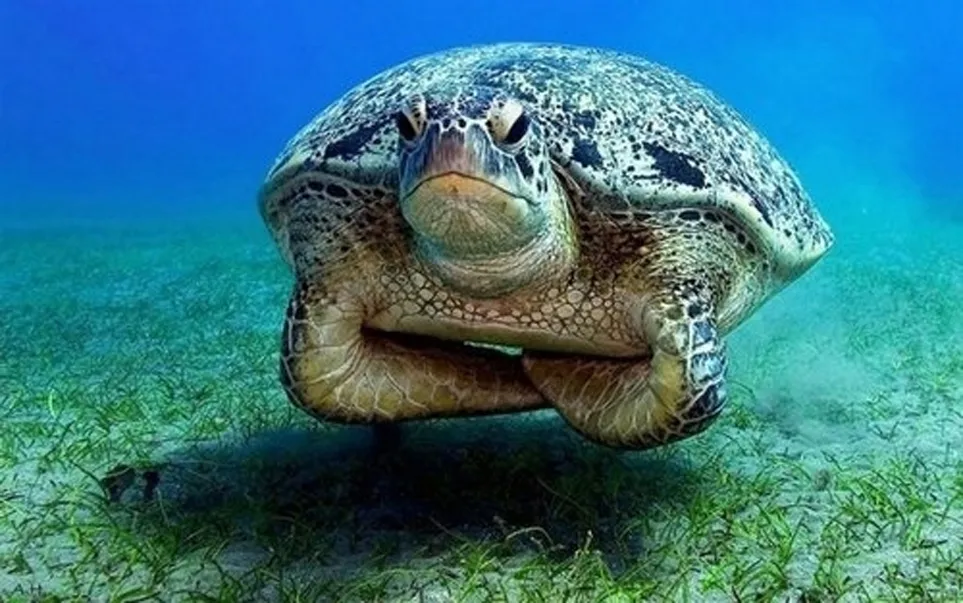We consider ourselves extremely fortunate to get to spend as much time as we do in the underwater world, diving among coral reefs and their incredible inhabitants. It has instilled a sense of responsibility to protect these special places which, tragically, are declining on a global scale. At Kona Diving Company, we are committed to diving in ways that minimize our effect on this environment. We also endeavor to act as ambassadors, equipped to help our divers observe and understand what makes our home unique in a way that does not harm or deteriorate it.
We ask every diver who joins us to please help us in this goal by keeping an open mind, an open heart and joining us in our commitment to responsible diving practices. We call it our Green Fins Policy and you can support us by following these guidelines and practices:
Keep your gear streamlined
For many divers, controlled stopping can be challenging. It puts our neutral buoyancy to the test when we pause to inspect something near the ocean floor without touching the bottom. This is especially important in coral-dense environments, where touching the bottom can cause breakage, but even in rubble or sand, there are still animals that live in those habitats. For divers still getting the hang of neutral buoyancy, consider staying a few extra feet higher off the bottom until you feel more confident in your buoyancy skills. Pay attention to your surroundings and be proactive rather than reactive with your buoyancy adjustments.
If your fins seem to naturally settle on the reef when you stop, ask us about re-positioning your weight so that horizontal trim is easier to achieve. Proper weight positioning is essential to good buoyancy and certain physical attributes (such as muscular legs) can be a factor requiring specific weighting needs.
We get it, mistakes happen. If you’re in a situation where touching the bottom will be unavoidable, try to minimize your impact as much as possible. Try to choose a spot that doesn’t clearly have life on it (such as bare rock) and then use a fingertip or, better yet, a reef stick to gently push yourself off.
Add a reef stick to your kit
If you like to have a closer look at little objects or to take pictures of animals up close, consider using a reef stick to stabilize yourself. You can even use them as an anchor in sand or muck habitats. Reef sticks are inexpensive, lightweight and easy to travel with. When used responsibly (not as an excuse to poke things), they are a very useful tool. On that note…
Respect the environment, respect the animals
For many divers, it’s the encounters with ocean’s unique residents that make scuba diving so thrilling. Every diver learns in their Open Water training class not to harass animals, but some divers don’t recognize certain behaviors as disturbing to wildlife. Even well-meaning divers can sometimes cause unintentional harm.
Our talented crew of dive masters have years of experience and are happy to guide you through respectful encounters with our incredible ocean neighbors. Listen carefully to your dive master’s briefings and follow their lead when observing wildlife. Emulate your guide’s behavior by paying close attention to how much space they give different animals, how quickly they approach and where they position themselves in the water column.
To an animal, divers can appear big, loud and scary! Many animals are going to be fearful when they see a group of divers approaching. Give animals ample space, try to position yourself in a non-threatening way (not directly above) and always leave them an escape route. Most importantly, know when to leave an animal alone.
The best combination for authentic animal interactions? Controlled buoyancy and patience. Once they’ve overcome their initial fear, most animals will eventually relax and engage in natural behavior if you observe calmly from a respectful distance.
Keep your fins up, don’t kick up sand
There are several different fin techniques to utilize and each have their time and place. Most people learn to dive utilizing the flutter kick, which is efficient for propulsion, but has a tendency to kick up sensitive substrates such as sand or silt. Frog kicking is a much better option for sensitive substrate than traditional flutter kicks. Don’t know how to frog kick? Ask one of our helpful crew to show you, or better yet…
Take a Peak Performance Buoyancy Specialty class
Controlled buoyancy and understanding how to move efficiently through the water are cornerstones of responsible diving practices. In just two dives (one charter) with a private instructor, you can earn a PADI Peak Performance Buoyancy Specialty certification and take a huge step on the journey toward buoyancy mastery. Regardless of your experience, there’s always ways to improve and our instructors will cater the class to your specific needs.
Not only does this class improve your buoyancy skills, but better buoyancy results in better air consumption, less exertion and a toolkit of alternative fin techniques to utilize in various habitats. Dive like a pro!
Be a courteous and conscientious camera user
With so many accessible options and a “pics or it didn’t happen” culture, cameras are frequent underwater companions these days – even for new divers. In truth, not every diver is ready for a camera. Before adding a camera, even something simple like a GoPro, consider if your buoyancy skills and situational awareness can handle the additional task loading. Too many times, we see divers compromise their and their dive teams’ safety trying to get a shot. Alternatively, sometimes their attention to their camera puts the very environment and animals they’re hoping to document in harm’s way.
If you do decide to add a camera to your setup, start with something manageable to your experience level and practice with it on land before you take it underwater. We also recommend not using it the entire dive, rather, focus on documenting particular points of interest. If you find that it’s becoming a distraction or a hazard, have a way to put it away (put it in a pocket, clip it to your gear, etc.) preferably in a way that allows you to have both hands free if necessary.
Be courteous to other divers in your group who will also want a look at that dragon moray or to take a picture of that frogfish. Please share the wildlife. For guests who may wish to take more time with an animal to get “the shot,” consider hanging back until the other members of your group have had a chance to see it first or better yet, consider a private guide so you don’t have to share.
When you use a camera underwater, you still have an obligation to make responsible dive practices your first priority. If we see that your dive safety or care for the environment is suffering due to use of a camera, we may ask you to leave it behind on the next dive.
Developing responsible diving skills and habits is a process that takes time and deliberate practice. Regardless of our experience level, there is always room to improve and we love helping our guests on their journey to be better divers. However, repeat offenders to these practices who demonstrate blatant disregard for our Green Fins Policy will not be welcomed back to dive with us again.

